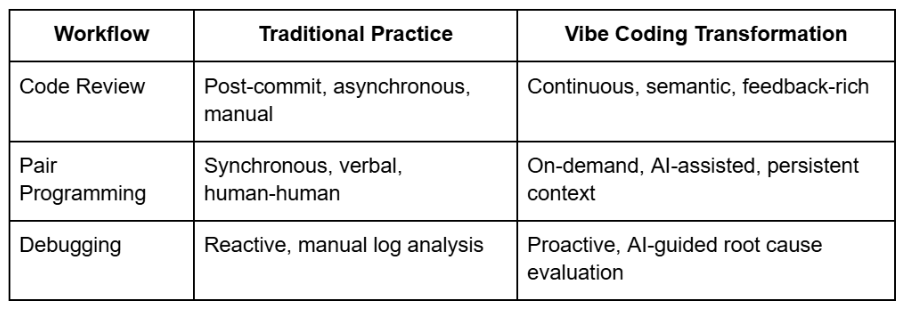
Modern software engineering teams are under constant pressure to deliver high-quality code faster, with fewer bugs and more collaborative input. While traditional workflows such as code reviews, pair programming, and step-debugging have served well in the past, they are increasingly inadequate for the velocity and complexity of today’s codebases.
Enter vibe coding, a paradigm that introduces intelligent AI agents into the heart of your development workflow. These agents are not limited to autocomplete suggestions or syntax checks. They operate as intelligent, context-aware collaborators who assist throughout the software development lifecycle. Vibe coding fundamentally transforms the way developers conduct code reviews, engage in pair programming, and identify and resolve bugs. This blog explores each of these facets in depth, providing technical insights into how vibe coding is redefining engineering dynamics in high-performance environments.
Vibe coding is a methodology where developers co-create software with context-aware, conversational AI agents directly integrated into their Integrated Development Environments (IDEs) such as VS Code or JetBrains IDEs. These agents maintain persistent context, understand project-specific conventions, architectural patterns, and recent code changes, and respond to natural language queries with executable suggestions. Unlike static linters or ephemeral autocomplete models, vibe coding agents offer dynamic, evolving interactions that span across:
Vibe coding augments the developer's cognitive load by offloading boilerplate, exploring alternative implementation paths, and keeping track of logical consistency across modules. Let us now explore how this impacts three critical aspects of engineering workflows: code reviews, pair programming, and debugging.
Code reviews are traditionally asynchronous and occur after a feature branch is complete. Developers open pull requests, assign reviewers, and wait for feedback. This model introduces several friction points:
The reviewer is expected to understand not only the diff but also the underlying reasoning, edge cases, and integration points, often without adequate tooling support. Review quality, as a result, becomes inconsistent and varies based on individual expertise and available time.
Vibe coding integrates review feedback directly into the development loop. Here is how the process changes:
This transforms the review process from a gating mechanism to a continuous refinement mechanism. Developers receive guidance as they write, not after the fact. Senior reviewers can focus on architectural discussions instead of nitpicking style or testing completeness. Review latency is reduced, merge conflicts become less frequent, and the code quality improves organically over time.
Conventional pair programming has proven benefits, including knowledge transfer, real-time problem solving, and reduced bug rates. However, it also introduces operational costs:
The process is highly dependent on human attention, communication clarity, and shared mental models. These factors become bottlenecks in fast-paced, distributed teams.
In vibe coding workflows, developers partner with AI agents that continuously adapt to their style, domain logic, and code history. These agents perform the following tasks in a pairing scenario:
The vibe coding model supports asynchronous, on-demand interaction. Developers no longer need to schedule pairing sessions. They can initiate a session with the AI, explore design patterns, compare approaches, or validate architecture as needed, without any human scheduling friction. This results in:
Debugging is one of the most cognitively demanding tasks in software engineering. Traditional methods involve setting breakpoints, reproducing bugs, reading logs, and correlating stack traces across distributed services. This process is:
Moreover, in systems with high concurrency or event-driven architectures, reproducing bugs deterministically becomes nearly impossible.
Vibe coding agents transform debugging into a proactive, context-rich process. Here are several capabilities that demonstrate this shift:
With vibe coding, the debugging loop becomes:
This loop creates a feedback-rich ecosystem where debugging becomes a dialogue, not a solo investigation.

Engineering leaders aiming for high code velocity and quality should seriously consider embedding vibe coding agents in their pipelines. The benefits extend beyond individual productivity:
Vibe coding agents act as second brains, allowing engineers to operate at a higher level of abstraction, focusing on system modeling and product logic rather than implementation overhead.
Vibe coding is not just an evolution of the IDE. It represents a structural shift in how developers think, collaborate, and build software. By integrating AI agents directly into the flow of authoring, reviewing, pairing, and debugging, developers gain continuous feedback, faster iterations, and deeper understanding of their systems.
The future of software engineering lies in augmenting human intelligence with persistent, adaptable, and context-rich AI collaboration. As vibe coding becomes mainstream, teams that adopt it early will not only ship faster but also build more robust, maintainable systems. Now is the time to integrate vibe coding into your development lifecycle and unlock a new dimension of engineering productivity.